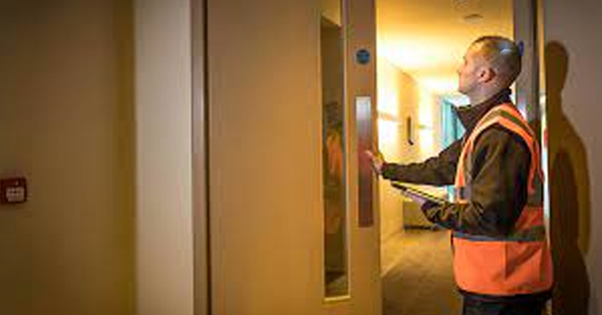INSPECTING FIRE DOORS: WHAT YOU NEED TO KNOW
Fire doors play an essential role in protecting occupants and property during a fire. As such, regular inspections are crucial for maintaining the efficacy of fire doors. In the UK, fire doors are required by law in most buildings and it is the responsibility of the building owner or manager to ensure that they are inspected regularly. For anyone uncertain of fire door inspection requirements in the UK, this article is an in-depth breakdown of what you need to know.
Are fire door inspections a legal requirement?
In the UK, fire doors are legally required in certain types of buildings, such as high-rise buildings (e.g. residential flats), commercial properties and ‘high-risk’ buildings such as hospitals and care homes. These doors must also be subject to regular risk assessments. Failure to comply with UK regulations outlined in Approved Document B and BS 8214 can result in legal action against anyone deemed to be a ‘responsible person’ in the event of a fire. For more in-depth guidance, consult our blog on fire door regulations.
What is involved in inspecting fire doors?
Inspecting a fire door means thoroughly assessing its condition to identify anything that may compromise its performance. This assessment must be carried out by a certified specialist, in accordance with a detailed, structured process. The specialist will recommend the door to either be repaired or in some instances replaced entirely. For example, if there is any damage to the door, or there are any physical gaps between the door and frame in excess of 4mm, the door must be replaced in its entirety.
Understanding fire door inspection requirements
As mentioned above, Approved Document B and BS 8214 are the core pieces of legislation that set the requirements for fire doors, including materials, methods and products used in installations. Here are some of their main takeaways regarding fire door inspection requirements:
Identification
Building owners or managers should be able to identify all fire doors in their buildings and show evidence that they have been properly installed and maintained. This includes fire doors in communal spaces such as hallways and stairways, as well as fire doors at entrances to flats and other private spaces.They must also be able to provide evidence that any fire doors being inspected are ‘primary tested’ fire doors. This proves that the door has not only been tested to the relevant standards but in its fully assembled state (including all components such as hinges, locks and seals). Ultimately a fire door must function as a complete set, and one non-compliant element can render a fire door ineffective.
Competence
The individuals responsible for inspecting fire doors should have a recognised industry-level certification such as FIRAS or BM TRADA. This means that they have the level of expertise required to identify defects or issues affecting fire doors.
Inspection scope
Fire door inspections should include a visual inspection of the door and its frame, hinges, intumescent seals, glazing, and ironmongery. The inspector should also ensure that the door closes correctly and that any gaps or signs of damage are repaired promptly.
Reporting
The findings of the fire door inspection should be documented in a report as part of widespread efforts to adhere to the golden thread approach. This is an essential requirement for maintaining full transparency in reporting and transferring safety information over the lifespan of the building. Reports must include any defects, issues identified and necessary corrective actions. They must also be kept up to date and made available to the building owner, manager and any relevant authorities where possible.
Maintenance
Any issues flagged during the fire door inspection should be addressed as a priority, in line with requirements set out in Approved Document B and BS 8214, and then maintained to the required standards with regular follow-up inspections.
What features are tested in a fire door inspection?
For a fire door inspection to be fully-compliant, the following elements must be scrutinised by a certified inspector for any signs of degradation or misuse:
Door leaf
Putting it simply, the door leaf is what opens and shuts. It should be checked for damage, warping, or twisting that could impact its ability to seal gaps and prevent smoke and flames from spreading. It must sit against the doorstop and flush with the frame, with the maximum gap between the door and the frame being 4mm.
Intumescent seals
The intumescent seals around the perimeter of the door and frame should be checked to ensure they are intact and free from damage. As of January 2023, seals should be inspected for wear or compression every 3 months so that smoke leakage is restricted to a rate of 3m³/m/hour.
Ironmongery
The ironmongery, such as hinges, locks, and door closers must be correctly installed, functioning correctly, and in good condition. There should be no less than 3 CE marked BS EN 1935 hinges on a fire door and all screws must be intact and firmly in place. Intumescent pads must also be fitted under all hinges.
Gaps and clearance
The gaps between the door and frame need to be within the recommended tolerances. If there are any excessive gaps, the inspector will recommend that they are sealed with appropriate fire stopping materials.
Signage
The signage on the door has to be present, legible, and correctly positioned at eye level on both sides of the door leaf. For self-closing fire doors, the correct signage is “Fire Door Keep Shut”, for manual fire doors it is “Fire Door Keep Locked”, and for automatic fire doors it is “Automatic Fire Door Keep Open”.
Closing mechanism
The door should close automatically and completely, and any closing mechanisms need to be working correctly and not leaking oil. The door cannot rub against the floor, the door closing speed must be approximately 10 seconds when opening at a 90-degree angle, and the door should not be wedged open at any time.
Certification
The fire door should be a primary tested door with a full audit trail that indicates the product meets relevant fire safety standards. The fire door must also have the correct FD rating in line with the risk assessment. Generally, fire doors in residential buildings will be FD30 or FD60, meaning that they offer 30 or 60 minutes of fire resistance.
How often should fire doors be inspected?
The frequency of fire door inspections in the UK depends on several factors, including the type of building, occupancy, and the level of risk associated with it. Different types of fire doors may also have different inspection requirements based on their location and use. Here is a general guideline from the Fire Safety (England) Regulations 2022 on how often different types of fire doors should be inspected in the UK:
- All fire doors in common or communal areas must be checked on a quarterly basis (every three months).
- All flat entrance doors into common or communal areas, including self-closing doors, must be checked on a best endeavour basis every 6 months.
Additional suggested guidelines include the following:
- If buildings (or sections of a building) are newly occupied, inspections may have to be more frequent over the first year of use.
- Fire doors that are in high-traffic areas, are more susceptible to damage or may require specialised materials and hardware, should be inspected more frequently.
It is important to note that these are general guidelines, and the frequency of fire door inspections should be determined based on the building’s fire risk survey. Also, any significant changes to the building, such as extensions or renovations, may require additional inspections.
The importance of an audit trail for fire door inspections
An audit trail is fundamental to the golden thread, as it creates a record of a fire door’s history, all the way from the manufacturing and testing process to the end of its lifespan. This includes, as previously mentioned, evidence that a fire door is a primary tested door.
If the fire door passes the test and meets the specified performance requirements, it is granted a certification to confirm it has been tested to the required standards and deemed compliant by a trained specialist.
An audit trail is also important as part of the general record-keeping of the building through its lifespan and operation, as it provides evidence of steps taken to safeguard a building’s occupants, and helps responsible parties keep on top of maintenance requirements.












Leave A Comment